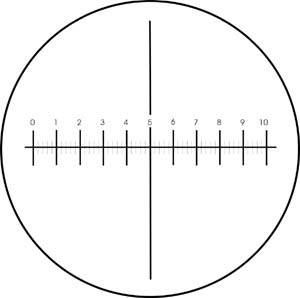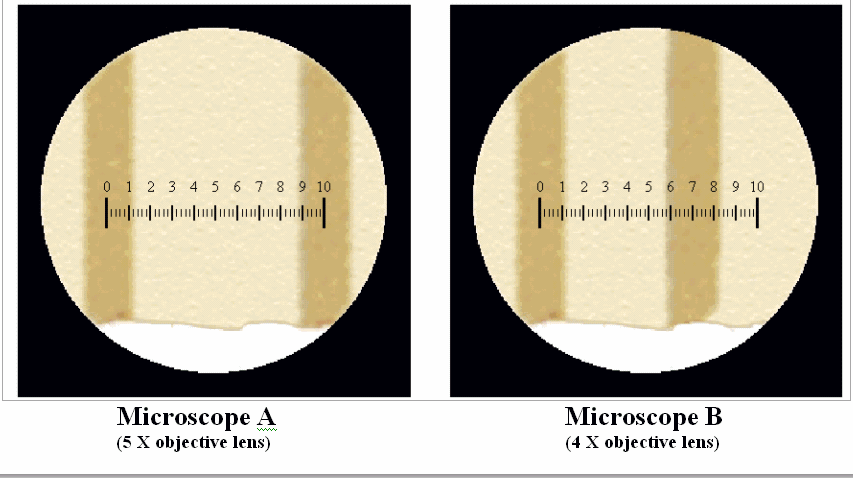BIOL 1406
PreLab
4.1
How do I calibrate a reticle?
 |
A reticle is used to measure objects viewed with the
microscope. When you look through the ocular of your microscope, the reticle
looks like a small ruler superimposed on the specimen you are viewing. As
you increase the magnification of your objective, the image of your specimen
increases in size, but the size of the reticle does not change.
The cross-lines on a reticle do not represent standard units of measurement,
such as millimeters or micrometers. They are simply arbitrary markings
superimposed on the specimen. In order to use these “reticle units” to measure a
specimen, you must calibrate the reticle. This means you must determine the
relationship between a “reticle unit” and a standard unit of measurement. As an
analogy, suppose you asked a carpet installer to give you an estimate for
carpeting your living room based on the following information: “My living room
is 10 tiles wide by 15 tiles long”. It would be impossible for the installer to
provide an estimate based on this information because a “tile” is not a standard
unit of measurement. Are these large Saltillo tiles, medium vinyl tiles, or
small ceramic tiles? In other words, the installer doesn’t know what the size of a
“tile” is, although he does know the size of standard units such as inches,
feet, or meters. In order for the installer to know how large your room is, you
could use a ruler to “calibrate” your tiles, i.e. convert the non-standard unit
called a “tile” into standard units such as inches. If the installer knows that
each tile is 8 inches long by 8 inches wide, then he can give you an accurate
estimate.
To further complicate matters when measuring objects with a reticle, if you
increase the magnification of your objective, the size of the image you are
viewing gets larger but size of the reticle units remains unchanged. This means
your reticle must be calibrated for each objective that you use |
To calibrate a reticle, switch to the scanning or low-power objective, place a
clear plastic millimeter ruler on the stage, and then focus on the mm lines.
What you see will resemble the illustrations below. Notice that microscope A is
using an objective with a higher magnification than microscope B. Therefore, the
mm lines will look farther apart on microscope A compared to microscope B, even
though the size of the reticle units on both microscopes looks the same.
|
 |
Figure 4.1 Calibrating a reticle on 2 different microscopes using a ruler with
lines 1 mm apart
 Note: Different types of reticles are available, and individual microscopes
may vary slightly in their optics and powers of magnification. Therefore, you
must calibrate the reticle for each objective and for each particular microscope
that you use.
Note: Different types of reticles are available, and individual microscopes
may vary slightly in their optics and powers of magnification. Therefore, you
must calibrate the reticle for each objective and for each particular microscope
that you use.
 Careful! Do not be distracted by numbers on the reticle, if present. A reticle
unit is the smallest unit visible on the reticle. Notice that the reticles of
both microscopes shown above have a total of 50 reticle units, not 10.
Careful! Do not be distracted by numbers on the reticle, if present. A reticle
unit is the smallest unit visible on the reticle. Notice that the reticles of
both microscopes shown above have a total of 50 reticle units, not 10.
Assuming you have correctly determined the number of µm’s per reticle unit when
using one objective on your microscope, you can calculate the number of µm’s per
reticle unit for any other objective on the same microscope using the following
formula:
|
µm / r.u. (using original objective) x (Magnification of original objective
/ Magnification of the new objective) = µm / r.u. (
using new objective) |
Example calculation:
Using the 4X objective, let’s say you determined that for a
particular microscope one reticle unit represents 50 µm. If you want to know the
number of µm’s per r.u. when using the 40X objective on the same microscope, use
the formula above:
50 µm / r.u. (using 4X obj.) x (4X / 40X) = 5 µm / r.u. (using 40X obj.)
or
50 µm / r.u. x (0.1) = 5 µm / r.u.
In other words, if one r.u. equals 50 µm when using the 4X objective, then one
r.u. equals 5 µm when using the 40X objective.
Close this browser window to return
to Blackboard and complete the practice quiz and assessment quiz.

